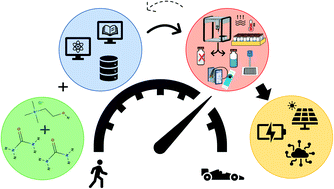High-throughput and data driven strategies for the design of deep-eutectic solvent electrolytes†
Abstract
Deep eutectic solvents (DESs) are an attractive class of materials with low toxicity, broad commercial availability, low costs and simple synthesis, which allows for tuning of their properties. We develop and demonstrate the use of high-throughput and data-driven strategies to accelerate the investigation of new DES formulations. A cheminformatics approach is used to outline a design space, which results in 3477 hydrogen bond donor (HBD) and 185 quaternary ammonium salt (QAS) molecules identified as good candidate components for DES. The synthesis methodology is then adapted to a high-throughput protocol using liquid handling robots for the rapid synthesis of DES combinations. High-throughput electrochemical characterization and melting point detection systems are used to measure key performance metrics. To demonstrate the new workflow, a total of 600 unique samples are prepared and characterized, corresponding to 50 unique DES combinations at 12 HBD/QAS molar ratios. After synthesis, a total of 230 samples are found liquid at room temperature and further characterized. Several DESs display conductivities above 1 mS cm−1, with a maximum recorded conductivity of 13.7 mS cm−1 for the combination of acetylcholine chloride (20 mol%) and ethylene glycol. All liquid DES samples show stable potential windows greater than 3 V. We also demonstrate that these DESs are electrochemically limited by viscosity, both in the conductivity and in the limiting processes on their cyclic voltammograms. Comparison with literature reports shows good agreement for properties measured in the high-throughput study, which helps to validate the workflow. This work demonstrates new methods to accelerate the collection of key DES metrics, providing data to formulate robust property prediction models and obtaining insight on interactions between molecular components. Data-driven high-throughput experimentation strategies can accelerate DES development for a variety of applications. Moreover, these approaches can also be extended to tackle other materials challenges with large molecular design spaces.



 Please wait while we load your content...
Please wait while we load your content...